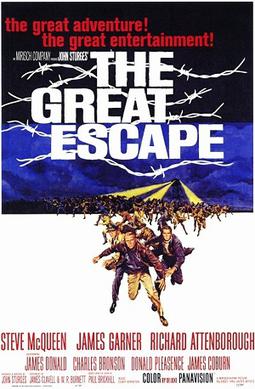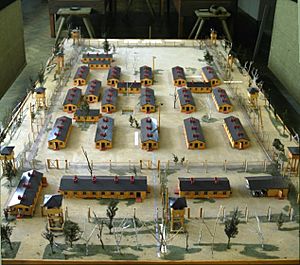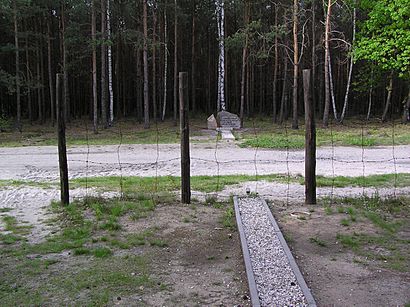The Great Escape (movie) facts for kids
Quick facts for kids The Great Escape |
|
|---|---|

Theatrical release poster by Frank McCarthy
|
|
| Directed by | John Sturges |
| Produced by | John Sturges |
| Screenplay by |
|
| Starring | |
| Music by | Elmer Bernstein |
| Cinematography | Daniel L. Fapp |
| Editing by | Ferris Webster |
| Studio | The Mirisch Company |
| Distributed by | United Artists |
| Release date(s) | June 20, 1963 (London) July 4, 1963 (United States) |
| Running time | 172 minutes |
| Country | United States |
| Language |
|
| Budget | $3.8 million |
| Money made | $11.7 million |
The Great Escape is a 1963 American epic war suspense adventure film starring Steve McQueen, James Garner and Richard Attenborough and featuring James Donald, Charles Bronson, Donald Pleasence, James Coburn, Hannes Messemer, David McCallum, Gordon Jackson, John Leyton and Angus Lennie. It was filmed in Panavision, and its musical score was composed by Elmer Bernstein.
Based on Paul Brickhill's 1950 non-fiction book of the same name, the film depicts a heavily fictionalized version of the mass escape by British Commonwealth prisoners of war from German POW camp Stalag Luft III during the Second World War. The film made numerous compromises for its commercial appeal, including its portrayal of American prisoners' involvement in the escape.
The Great Escape was made by The Mirisch Company, released by United Artists, and produced and directed by John Sturges. The film had its Royal World Premiere at the Odeon Leicester Square in London's West End on 20 June 1963. The Great Escape received critical acclaim and emerged as one of the highest-grossing films of the year, winning McQueen the award for Best Actor at the Moscow International Film Festival, and is considered a classic. The film is also noted for its motorcycle chase and jump scene, which is considered one of the best stunts ever performed.
Cast
- Steve McQueen as Captain Virgil Hilts ('The Cooler King'): one of three Americans in the camp, a particularly persistent escapee with an irreverent attitude.
- James Garner as Flight Lieutenant Bob Hendley ('The Scrounger'): American RAF officer, responsible for finding materials on the black market for the escape attempt; forms a close friendship with Blythe.
- Richard Attenborough as Squadron Leader Roger Bartlett ('Big X'): RAF officer and ringleader of the escape committee.
- James Donald as Group Captain Ramsey ('The SBO'): most senior British & Allied officer in the camp, serves as an intermediary between the Germans and the POWs as their de facto leader.
- Charles Bronson as Flight Lieutenant Danny Welinski ('Tunnel King'): Polish RAF officer; despite having dug 17 escape tunnels in other camps, is severely claustrophobic.
- Donald Pleasence as Flight Lieutenant Colin Blythe ('The Forger'): mild-mannered English forger; forms close friendship with Hendley.
- James Coburn as Flying Officer Sedgwick ('The Manufacturer'): an Australian officer who constructs tools for the escape.
- Hannes Messemer as Oberst von Luger ('The Kommandant'): Commandant of the camp and a senior Luftwaffe officer.
- David McCallum as Lieutenant-Commander Eric Ashley-Pitt ('Dispersal'): a Fleet Air Arm officer; devises a way to get rid of the tunnel dirt.
- Gordon Jackson as Flight Lieutenant Alexander MacDonald ('Intelligence'): Bartlett's second-in-command.
- John Leyton as Flight Lieutenant Willie Dickes ('Tunnel King'): Welinski's best friend and co-lead on tunnel design and construction.
- Angus Lennie as Flying Officer Archie Ives ('The Mole'): anxious Scottish airman who befriends Hilts in the cooler.
- Nigel Stock as Flight Lieutenant Dennis Cavendish ('The Surveyor'): surveys the tunnel routes.
- Robert Graf as Werner ('The Ferret'): young, naive guard whom Hendley befriends and exploits for black market contraband.
- Jud Taylor as Second Lieutenant Goff: the camp's third American.
- Hans Reiser as Kuhn: Gestapo officer and ardent Nazi.
- Harry Riebauer as Stabsfeldwebel Strachwitz: the senior NCO amongst the German guards.
- William Russell as Sorren ('Security'): British officer.
- Robert Freitag as Hauptmann Posen: von Luger's adjutant.
- Ulrich Beiger as Preissen: Gestapo officer.
- George Mikell as SD Hauptsturmführer Dietrich: SS officer.
- Lawrence Montaigne as Haynes ('Diversions'): Canadian officer.
- Robert Desmond as Griffith ('Tailor'): British officer; provides civilian clothes and military uniforms to disguise the escapees.
- Til Kiwe as Frick
- Heinz Weiss as Kramer
- Tom Adams as Dai Nimmo ('Diversions'): Welsh officer.
- Karl-Otto Alberty as SD Untersturmführer Steinach: SS officer.
Production
Writing
In 1963, the Mirisch brothers worked with United Artists to adapt Paul Brickhill's 1950 book The Great Escape. Brickhill had been a very minor member of the X Organisation at Stalag Luft III, who acted as one of the "stooges" who monitored German movements in the camp. The story had been adapted as a live TV production, screened by NBC as an episode of The Philco Television Playhouse on January 27, 1951. The live broadcast was praised for engineering an ingenious set design for the live broadcast, including creating the illusion of tunnels. The film's screenplay was adapted by James Clavell, W. R. Burnett and Walter Newman.
Casting

Steve McQueen, Charles Bronson and James Coburn all had recently worked with director John Sturges on his 1960 motion picture, The Magnificent Seven.
Steve McQueen has been credited with the most significant performance. Critic Leonard Maltin wrote that "the large, international cast is superb, but the standout is McQueen; it's easy to see why this cemented his status as a superstar". This film established his box-office clout. Hilts was based on at least three pilots, David M. Jones, John Dortch Lewis and Bill Ash.
Richard Attenborough's Sqn Ldr Roger Bartlett RAF, "Big X", was based on Roger Bushell, the South African-born British POW who was the mastermind of the real Great Escape. This was the film that first brought Attenborough to common notice in the United States. During World War II, Attenborough served in the Royal Air Force. He volunteered to fly with the Film Unit, and after further training (where he sustained permanent ear damage), he qualified as a sergeant. He flew on several missions over Europe, filming from the rear gunner's position to record the outcome of Bomber Command sorties. (Richard Harris was originally announced for the role.)
Group Captain Ramsey RAF, "the SBO" (Senior British Officer), was based on Group Captain Herbert Massey, a World War I veteran who had volunteered in World War II. Massey walked with a limp, and in the movie Ramsey walks with a cane. Massey had suffered severe wounds to the same leg in both wars. There would be no escape for him, but as SBO he had to know what was going on. Group Captain Massey was a veteran escaper himself and had been in trouble with the Gestapo. His experience allowed him to offer sound advice to the X-Organisation. Another officer who is likely to have inspired the character of Ramsey was Wing Commander Harry Day.
Flt Lt Colin Blythe RAF, "The Forger", was based on Tim Walenn and played by Donald Pleasence. Pleasence had served in the Royal Air Force during World War II. He was shot down and spent a year in German prisoner-of-war camp Stalag Luft I. Charles Bronson had been a gunner in the USAAF and had been wounded, but never shot down. Like his character, Danny Welinski, he suffered from claustrophobia because of his childhood work in a mine. James Garner had been a soldier in the Korean War and was twice wounded. He was a scrounger during that time, as is his character.
Hannes Messemer's Commandant, "Colonel von Luger", was based on Oberst Friedrich Wilhelm von Lindeiner-Wildau. Messemer had been a POW in Russia during World War II and had escaped by walking hundreds of miles to the German border. He was wounded by Russian fire, but was not captured by the Russians. He surrendered to British forces and then spent two years in a POW facility in London known as the London Cage.
Angus Lennie's Flying Officer Archibald Ives, "The Mole", was based on Jimmy Kiddel, who was shot dead while trying to scale the fence.
The film is accurate in showing that only three escapees made home runs, although the people who made them differed from those in the film. The escape of Danny and Willie in the film is based on two Norwegians who escaped to Sweden, Per Bergsland and Jens Müller, while the escape of Royal Australian Air Force (RAAF) Flying Officer Sedgwick, "the Manufacturer", to Spain, was based on Dutchman Bram van der Stok. James Coburn, an American, was cast in the role of Sedgwick who was an amalgamation of Flt Lt Albert Hake, an Australian serving in the RAF, the camp's compass maker, and Johnny Travis, the real manufacturer.
Tilman 'Til Kiwe' Kiver played the German guard "Frick", who discovers the escape. Kiwe had been a German paratrooper officer who was captured and held prisoner at a POW camp in Colorado. He made several escape attempts, dyeing his uniform and carrying forged papers. He was captured in the St. Louis train station during one escape attempt. He won the Knight's Cross before his capture and was the cast member who had actually performed many of the exploits shown in the film.
Filming
The film was made on location in Germany at the Bavaria Film Studio in the Munich suburb of Geiselgasteig in rural Bavaria, where sets for the barrack interiors and tunnels were constructed. The camp was built in a clearing of the Perlacher Forst (Perlacher Forest) near the studio. The German town near the real camp was Sagan (now Żagań, Poland); it was renamed Neustadt in the film. Many scenes were filmed in and around the town of Füssen in Bavaria, including its railway station. The nearby district of Pfronten, with its distinctive St. Nikolaus Church and scenic background, also appears often in the film. The first scenes involving the railway were filmed on the Munich–Holzkirchen line at Großhesselohe station ("Neustadt" station in the movie) and near Deisenhofen. Hendley and Blythe's escape from the train was shot on the Munich–Mühldorf railway east of Markt Schwaben. The station where Bartlett, MacDonald and Ashley-Pitt arrive is Füssen station, whereas the scene of Sedgwick (whose theft of a bike was shot in Markt Schwaben) boarding a train was created in Pfronten-Ried station on the Ausserfern Railway. The castle Hendley and Blythe fly by while attempting to escape is Neuschwanstein Castle.
The motorcycle chase scenes with the barbed wire fences were shot on meadows outside Füssen, and the "barbed wire" that Hilts crashes into before being recaptured was simulated by strips of rubber tied around barbless wire, constructed by the cast and crew in their spare time. Insurance concerns prevented McQueen from performing the film's notable motorcycle leap, which was done by his friend and fellow cycle enthusiast Bud Ekins, who resembled McQueen from a distance. When Johnny Carson later tried to congratulate McQueen for the jump during a broadcast of The Tonight Show, McQueen said, "It wasn't me. That was Bud Ekins." However, McQueen and Australian Motocross champion Tim Gibbes both performed the stunt on camera for fun, and according to second unit director Robert Relyea, the stunt in the final cut of the movie could have been performed by any of the three men. Other parts of the chase were done by McQueen, playing both Hilts and the soldiers chasing him, because of his skill on a motorcycle. The motorcycle was a Triumph TR6 Trophy which was painted to look like a German machine. The restored machine is currently on display at Triumph's factory at Hinckley, England.
Historical accuracy

The film was largely fictional, with changes made to increase its drama and appeal to an American audience, and to serve as vehicle for its box-office stars. Many details of the actual escape attempt were changed for the film, including the roles of American personnel in both the planning and the escape. While the characters are fictitious, they are based on real men, in most cases being composites of several people. The screenwriters significantly increased the involvement of American POWs; a few American officers in the camp initially helped dig the tunnels and worked on the early plans. However, they were moved away seven months before the escape, which ended their involvement. The real escape was by largely British and other Allied personnel, with the exception of American Johnnie Dodge, who was a British officer. The film omits the crucial role that Canadians played in building the tunnels and in the escape itself. Of the 1,800 or so POWs, 600 were involved in preparations: 150 of those were Canadian. Wally Floody, an RCAF pilot and former miner who was the real-life "tunnel king", was engaged as a technical advisor for the film.
Ramsey tells Von Luger that it is the sworn duty of every officer to attempt escape. In reality, there was no requirement in the King's Regulations, or in any form of international convention.
The film omits any mention that many Germans willingly helped in the escape itself.
Music
The film's iconic music was composed by Elmer Bernstein, who gave each major character their own musical motif based on the Great Escape's main theme. Its enduring popularity helped Bernstein live off the score's royalties for the rest of his life. Critics have said the film score succeeds because it uses rousing militaristic motifs with interludes of warmer softer themes that humanizes the prisoners and endears them to audiences; the music also captures the bravery and defiance of the POWs. The main title's patriotic march has since become popular in Britain, particularly with sports such as fans of the England national football team. However, in 2016, the sons of Elmer Bernstein openly criticized the use of the Great Escape theme by the Vote Leave campaign in the UK Brexit referendum, saying "Our father would never have allowed UKIP to use his music" because he would have strongly opposed the party.
- Intrada Records (release)
In 2011 Intrada, a company specializing in film soundtracks, released a digitized re-mastered version of the full film score based on the original 1/4" two-track stereo sessions and original 1/2" three-channel stereo masters.
Sequel
A fictional, made-for-television sequel, The Great Escape II: The Untold Story, was released in 1988, with Christopher Reeve, and directed by Jud Taylor (who played 2nd Lt. Goff in the 1963 film). The film is not a true sequel, as it dramatizes the escape itself just as the original film does, although mostly using the real names of the individuals involved (whereas the original film fictionalized them and used composite characters).
See also
 In Spanish: The Great Escape para niños
In Spanish: The Great Escape para niños



